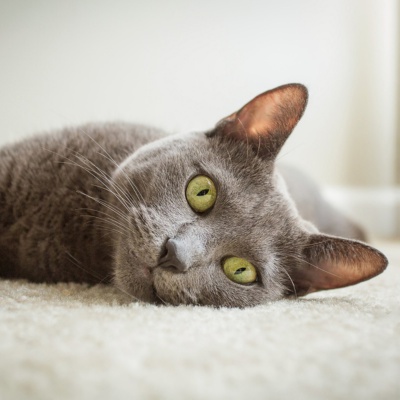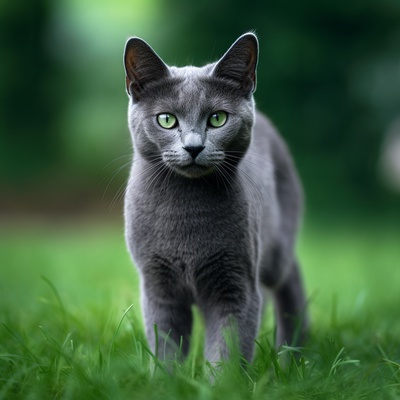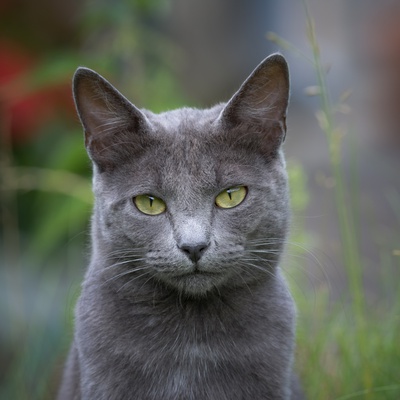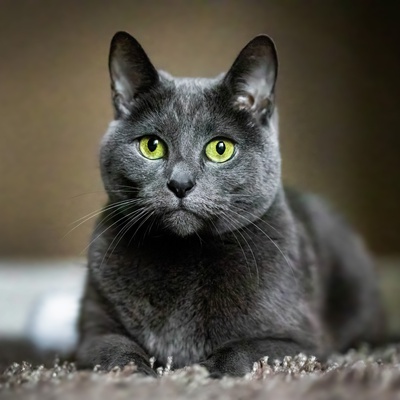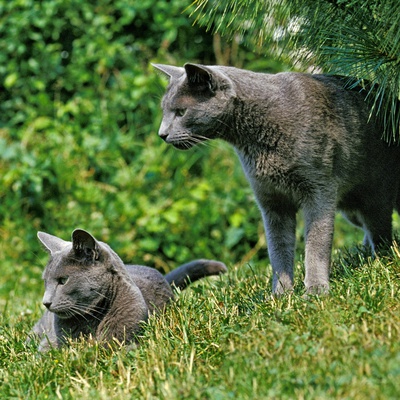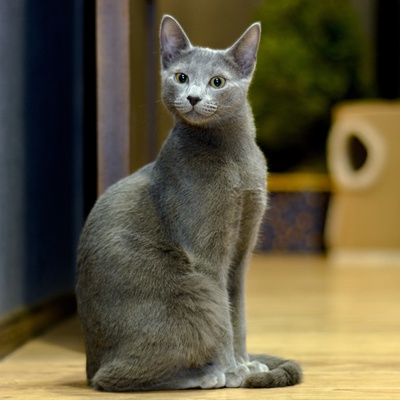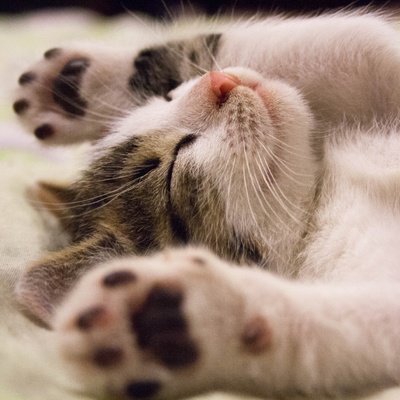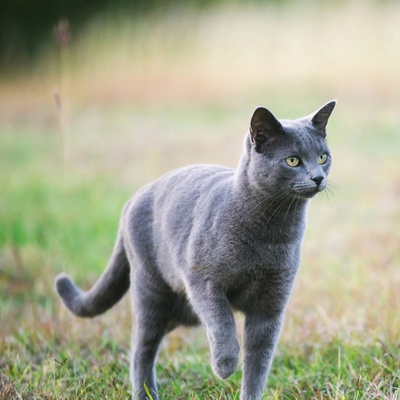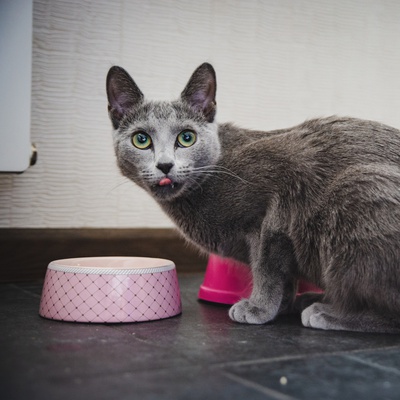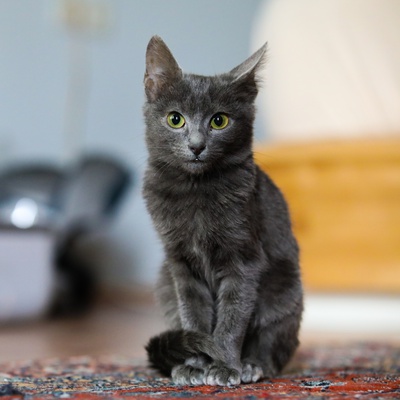Introducing the Russian Blue
Find out everything you need to know about the Russian Blue: its characteristics, its behaviour, its training and how much one costs.
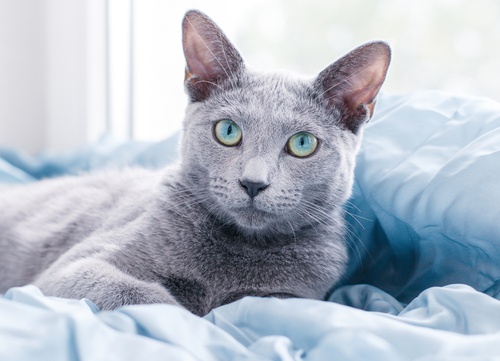
Find out everything you need to know about the Russian Blue: its characteristics, its behaviour, its training and how much one costs.
The Russian Blue is a truly captivating breed. This cat breed, originally hailing from the frosty climes of northern Russia, specifically the Archangel Isles, is a testament to the exquisite beauty that nature sometimes concocts. With its dense, plush coat of a unique silvery-blue hue and its vibrant, emerald-green eyes, the Russian Blue commands attention and admiration. Not only is this breed aesthetically pleasing, but its temperaments and behaviours are also of note.
Renowned for their calm demeanor, Russian Blue cats form deep bonds with their families. Striking a balance between playful vitality and tranquil companionship, they're an excellent choice for cat lovers. Their regal charm is sure to captivate you.
This selection outlines the unique features of the Russian Blue breed of cat.
The Russian Blue is a medium-sized cat, typically reaching heights of 10 inches and weighing between 7 to 12 pounds.
This breed boasts a short, plush coat that feels dense and luxurious to the touch, truly setting it apart from other breeds.
Interestingly, Russian Blues are known to be hypoallergenic, making them a suitable choice for cat lovers who otherwise suffer from allergies.
The Russian Blue, as suggested by the name, has a striking silvery-blue coat that can sometimes appear to shimmer in certain light.
Russian Blues are flexible and adapt well to various environments, although they prefer calm and stable surroundings.
They are friendly and social cats, suitable for families with children and they can even get along well with other pets after an initial period of caution.
Russian Blues are generally quite healthy, though they may be prone to obesity if their diet isn't properly managed.
Known for their intelligence and curiosity, Russian Blues are typically easy to train, responding well to gentle guidance and positive reinforcement.
We can help you!
Every cat has its own character and specific needs. Making the right choice will ensure his well-being and yours.
Thanks to our quiz, you'll know which breed is right for you, depending on your lifestyle, expectations and many other criteria.
Don't wait any longer and take the quiz to find out the answer!
The Russian Blue carries a distinct elegance. Its plush, shimmering silver-blue coat gives it an ethereal and enchanting appearance.
The Russian Blue is a medium-sized cat, standing typically at about 10 inches tall, with an appropriately proportionate body length. Females of this breed tend to be lighter, weighing between 7 and 10 pounds, whereas males can reach up to 12 pounds in weight.
Russian Blues are not fast growers. They continue to develop until they are around 3-4 years of age, making their growth period slightly longer than some other breeds. They are characterized by a robust skeletal structure, muscular body, and a long, graceful tail.
The Russian Blue has a short to medium-length coat. This breed is known for its dense, plush double coat that stands out from the body due to the presence of guard hairs, giving the cat a pampered, fluffy appearance. The Russian Blue is a hypoallergenic breed, perfect if you are prone to allergies.
The coat of the Russian Blue cat comes in one standard - a bright, shimmering blue. The colour is a uniform bluish-gray that deepens with the maturity of the cat. It is noteworthy that each hair is tipped with silver, creating a luminous, silvery sheen, especially under sunlight.
Beyond its distinct coat, the Russian Blue boasts a number of other striking physical characteristics. This breed has a graceful, medium to large body structure that is muscular and lithe, accentuated by long, slim legs. Its head is a wedge shape, broad at the skull and narrowing to a fine muzzle.
The eyes of a Russian Blue are one of its most captivating features - they are large, rounded and always a vivid green. All these traits come together to create the distinctive and enchanting appearance of the Russian Blue cat.
As for grooming, the Russian Blue's dense double coat benefits from a weekly brush to remove loose hairs and maintain its lustrous sheen. During the shedding seasons of spring and fall, more frequent brushing may be required.
While these cats breed are typically very clean and do a good job grooming themselves, an occasional bath with a cat-friendly shampoo can help to maintain the health and beauty of their coat.
Despite their plush coat, Russian Blues are known to shed less than many other breeds, which can be an added bonus for those prone to allergies.
The Russian Blue is known for its intelligent, gentle and reserved nature. Truly an endearing companion.
The Russian Blue exhibits a unique blend of distance and attachment. While it can be somewhat shy around strangers, this cat breed is known to form deep bonds with its human family. Once a Russian Blue forms an attachment, it's not unusual to find the cat following its human around the house, always desiring to be in the same room. They enjoy playtime but also appreciate lengthy cuddling sessions.
In terms of vocalization, Russian Blues are typically quiet, with a soft voice that often sounds like a purr or a meow-whisper. For someone willing to give them the necessary attention, the Russian Blue can make a wonderfully warm and devoted pet.
As a rule, Russian Blues are calm, poised, and easygoing. They embody an interesting mix of playful energy and serene passivity, creating a balanced temperament that makes them compatible with families, children, and even other pets. When faced with an overwhelming situation, instead of acting out, Russian Blues prefer to retreat and find a quiet space to relax. They are not typically aggressive, further solidifying their place as a peaceful and amiable feline companion.
Russian Blues are remarkably adaptable cats that can adjust well to different environments. While these cats enjoy the companionship of their humans, they are also capable of being self-sufficient and can comfortably handle periods of solitude. Whether in a bustling city apartment or a quiet suburban house, they can thrive as long as they have a safe, peaceful space to call their own. However, it's important to note that Russian Blues appreciate having enough room to roam and play, and if their need for activity is not met, they may develop undesirable behaviours.
Despite their elegant and refined appearance, Russian Blues need space to explore and exercise. If you're worried about losing track of your cats, you can fit them with a GPS collar so you can track their movements and locate them if they escape.
Starting the training as early as possible is crucial for Russian Blues. This breed is highly intelligent and picks up on things quickly. Their training should be based on principles of kindness, patience, positive reinforcement, and consistency.
Play-based training can be particularly effective with Russian Blues, as it not only engages them mentally but also aids in preventing the development of unwanted behaviours. This breed's intellectual abilities, coupled with their keen desire to please their humans, can make them an absolute delight to train.
Choosing a cat that matches your personality and lifestyle will ensure your well-being and his!
The Russian Blue is a tranquil and serene cat breed. They are known for their strong resilience and robust health, typically not prone to specific health issues which are common in other breeds.
Emphasising the robustness of Russian Blues, they are generally a very healthy breed and infrequently fall ill. However, like many other cat breeds, they can be susceptible to specific genetic diseases. These include hypertrophic cardiomyopathy, a heart condition, and polycystic kidney disease.
Fortunately, these are not common conditions and, where possible, breeders often use DNA testing to identify and avoid breeding cats with these genetic predispositions.
Despite their overall good health, regular veterinary check-ups are crucial. Routine vaccinations can protect them against common diseases like feline distemper and rabies, ensuring they remain as healthy as possible. It's worth remembering that preventive care is the best approach to maintain your Russian Blue's health.
The Russian Blue is a medium-sized cat, renowned for its muscular body and graceful figure. Preserving this sleek silhouette and overall health calls for a diet of high quality. Top-tier nutritional kibble is typically recommended as the primary food source.
To augment this diet, consider adding supplemental foods such as green vegetables, which have a high water content. These can serve to enhance their kibble while also supporting healthy kidney function.
The Russian Blue matures at a moderate pace, reaching full physical maturity around the age of two. This specific rate of growth necessitates an appropriate and regulated diet. To maintain dietary consistency, it is advisable to stick to the same brand of kibble.
Feeding your Russian Blue at fixed times is another crucial aspect of their care, helping avoid potential digestive system disruptions.
Russian Blues are known for their placid demeanor, often opting for lounging indoors over more energetic activities. This inclination, paired with an uncontrolled diet, can potentially lead to weight gain. Thus, it's essential to ensure your Russian Blue gets ample exercise to stave off any weight issues and promote overall health.
Encourage your cat to engage in games, running, and jumping. Interaction and play sessions with their owners are not only enjoyable for Russian Blues, but also provide much-needed stimulation and exercise.
Russian Blues are a well-appreciated breed, and numerous breeders across the globe specialize in these felines. It's important to take into account a few factors before adoption.
Pedigree cats such as Russian Blues are typically bred by professional breeders or catteries. Prior to adoption, visiting the breeding premises is advisable to observe the living conditions and ensure their quality.
From June 10, 2024 you must have your cat microchipped by the age of 20 weeks old and register its details in a relevant database such as Petlog or The Governing Council of the Cat Fancy (GCCF). This is a legal requirement in Britain, and failure to comply could result in a fine of
.
It is also essential to check that health examinations and DNA tests have been carried out on the kitten and its parents to identify any hereditary health problems.
The acquisition cost of a Russian Blue can fluctuate due to several factors. These can include lineage, pedigree, breeder reputation, and the age of the cat. Generally, the price of a Russian Blue kitten can range from
to
, though it can vary.
In addition to the acquisition cost, the maintenance of a Russian Blue also entails costs. The estimated annual cost associated with their upkeep is between
and
.
The Russian Blue has an average life expectancy of between 15 and 20 years. Remember, bringing a Russian Blue into your home is a long-term commitment, and all these factors should be taken into consideration before making a decision.
Choosing a cat that matches your personality and lifestyle will ensure your well-being and his!
To access the most relevant information, suitable payment methods, and delivery in your region, please select the website corresponding to your country.
